Although the vast Kgalagadi Transfrontier Park, straddling huge arid swathes of South Africa and Botswana, is the world’s largest nature park – and a UNESCO World Heritage site – it doesn’t get the appreciation and attention it deserves. This chunk of the Kalahari Desert, considerably larger than Wales, easily absorbs its annual 1.5 million visitors.
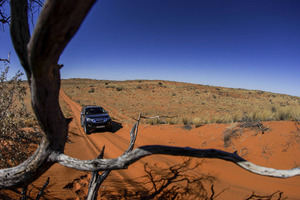 Only 2% of visitors to South Africa journey on to the Northern Cape, though the adventurous are beginning to take advantage of flights from Cape Town and Johannesburg through to Upington: a small town that sedately shimmers in the heat. Dropping down out of a vast blue sky there is a look of red-tinged Ayers Rock to the endless landscape beyond Upington’s heat-hazed runway.
Only 2% of visitors to South Africa journey on to the Northern Cape, though the adventurous are beginning to take advantage of flights from Cape Town and Johannesburg through to Upington: a small town that sedately shimmers in the heat. Dropping down out of a vast blue sky there is a look of red-tinged Ayers Rock to the endless landscape beyond Upington’s heat-hazed runway.
In the language of the indigenous Khomani San tribe, the Kgalagadi is ‘the Place of Thirst’. Yet, the Khomani San, as hunter-gatherers, survived and thrived in the red sand semi-desert of the Kalahari for millennia. It was only an edict of the South African Government in 1931 that expelled them from their homelands to create the Gemsbok National Park, the precursor to the Kgalagadi.
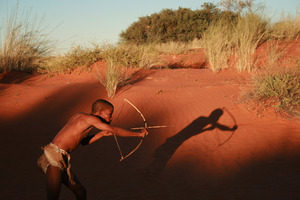 The Kgalagadi is very different to many other safari parks such as the Kruger. Some years there is as little as 6 inches annual rainfall, it’s rivers ‘run’ just once or twice a century, only after exceptional rainfall. Consequently, the Kgalagadi is not teeming with wild life. Geographers classify the Kgalagadi as semi-desert, trees are scarce but there are still over 220 species of bird.
The Kgalagadi is very different to many other safari parks such as the Kruger. Some years there is as little as 6 inches annual rainfall, it’s rivers ‘run’ just once or twice a century, only after exceptional rainfall. Consequently, the Kgalagadi is not teeming with wild life. Geographers classify the Kgalagadi as semi-desert, trees are scarce but there are still over 220 species of bird.
If you’ve never done a safari and are desperate to tick off the Big Five then the Kgalagadi is not the place: you certainly will not see an elephant. there just isn’t enough water for their needs. Free from swarming safari vehicles, ‘bakkies’ in the local lingo – and spared hordes of camera-clicking tourists – the Kgalagadi is slow travel, a slow safari through the micro lens, one for the David Attenborough stop-and-smell-the-lion-pooh-school of exploring. The Kgalagadi, a tapestry of burnt beige and muted greens, rewards patience: perhaps with desert truffles, perhaps with a carpet of yellow thorn flowers after rare rains, perhaps with a strutting Secretary Bird.
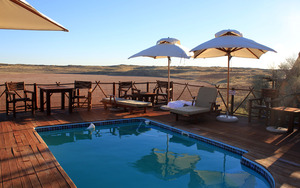 Literally at the heart of the Kalahari – and Xaus in the Bushman’s clicking language means heart, pronounced Kaus – sits Xaus Safari Lodge. Twenty-five miles from the nearest tarmac road, the lodge sends a robust bakkie for the final jolting leg of the journey. Xaus overlooks a salt-pan, where hyena, leopard, lion and springboks drink. The leopard is also partial to water from the swimming pool too.
Literally at the heart of the Kalahari – and Xaus in the Bushman’s clicking language means heart, pronounced Kaus – sits Xaus Safari Lodge. Twenty-five miles from the nearest tarmac road, the lodge sends a robust bakkie for the final jolting leg of the journey. Xaus overlooks a salt-pan, where hyena, leopard, lion and springboks drink. The leopard is also partial to water from the swimming pool too.
Sunrise safari walks, taken by a guide with decades of experience, provide intimidate down-on your knees knowledge of the landscape. Desert lore, the art of survival, in a seemingly hostile environment, has been handed down from the Bushman. Our guide digs up a succulent spiky Gemsbok cucumber, points out the Hoodia plant which the Khomani San used as an appetite depressant, to avoiding having to pause to eat when they were tracking an animal. Next is a one-ton Social Weaver’s nest where birds bring blade after blade of grass until the nest collapses. Humans are not the only species struggling with overpopulation.
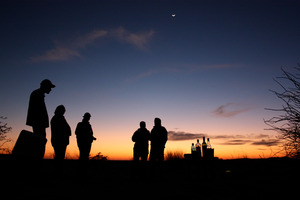 Throughout the park there are occasional bore-holes but only giraffes need the water provided. The Gemsbok and Springbok graze on dew-covered grass whilst lions survive on blood from their kills. Bushmen chewed on bitter Sawplant, to assuage their thirst, which we reluctantly tried.
Throughout the park there are occasional bore-holes but only giraffes need the water provided. The Gemsbok and Springbok graze on dew-covered grass whilst lions survive on blood from their kills. Bushmen chewed on bitter Sawplant, to assuage their thirst, which we reluctantly tried.
As Cape Town heads for Day Zero, the dreaded day when the water runs out, the Kgalagadi provides life lessons in minimalism. In scorching mid-day heat, sometimes hitting 45C, the Bushmen would find shade in a Shepherd’s Tree. Hid deep in the tree and allegedly the thorns would protect them from marauding lions.
Walking safaris and lions?
“Twice, in 20 years, I’ve been charged by lionesses. I guess I’d got too near their cubs. The first charge is a warning, they stopped about seven metres short. If they had charged again I wouldn’t be here,” our guide advised.
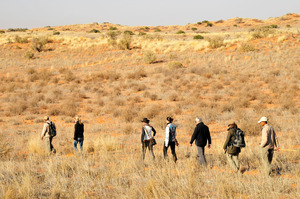 “Lions don’t like fire. Always carry a lighter. There’s usually enough dry brush to ignite. Or set fire to your T-shirt and put it on your stick. Don’t forget you’ll always be carrying a stick to sweep any cobras and pythons out of your path,” our guide continued, the tone somewhere between practical and macho.
“Lions don’t like fire. Always carry a lighter. There’s usually enough dry brush to ignite. Or set fire to your T-shirt and put it on your stick. Don’t forget you’ll always be carrying a stick to sweep any cobras and pythons out of your path,” our guide continued, the tone somewhere between practical and macho.
Long ago, before they were dispersed round the farms of the Northern Cape losing their culture and language, the Khomani San would drive game towards a lion. Once the lion had sated its hunger they would use a flaming brazier to scare the lions away from their meat.
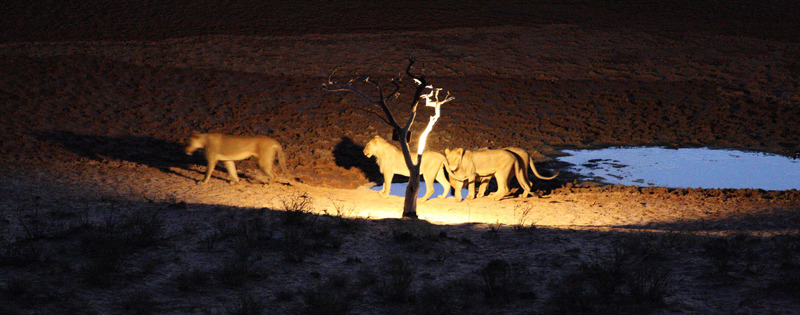
One of the highlights of the Kgalagadi is the dazzling Southern Hemisphere Sky yet that is tinged with sadness. Bushmen believe that on death they become a star. Seeing stars, actually the first satellites, whizzing round the earth in the 1960s and 1970s, the remnants of the Khomani San, believed their ancestors were angry at the loss of their heritage.
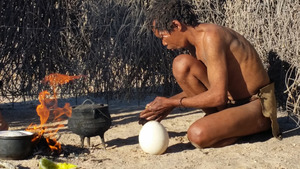 Much of the planet has to be protected from over-exploitation but the danger for the Kgalagadi is under-exploitation. It needs its tourism to develop, to boost the revenue from entrance fees coming through the park’s gates, to provide funding for the Khomani San to expand their Bushcraft Classes for their children, to develop more enterprises like Xaus and to provide employment that preserves their way of life. Frequently we are concerned about the extinction of animal species, with the Kalahari we should care about the preservation of a people.
Much of the planet has to be protected from over-exploitation but the danger for the Kgalagadi is under-exploitation. It needs its tourism to develop, to boost the revenue from entrance fees coming through the park’s gates, to provide funding for the Khomani San to expand their Bushcraft Classes for their children, to develop more enterprises like Xaus and to provide employment that preserves their way of life. Frequently we are concerned about the extinction of animal species, with the Kalahari we should care about the preservation of a people.











